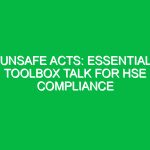Introduction
In the realm of health, safety, and Environment (HSE), one of the most pressing concerns is the issue of slips, trips, and falls. These incidents are not merely minor accidents; they represent a significant risk, affecting individuals in workplaces, homes, and public spaces alike. The leading cause of slips, trips, and falls is often attributed to environmental factors, such as wet or uneven surfaces, inadequate lighting, and obstacles in pathways. Understanding these causes is paramount for implementing effective Safety Measures and reducing the frequency of such incidents.
The relevance of this topic cannot be overstated. According to the National Safety Council, slips, trips, and falls account for a considerable percentage of workplace injuries, leading to lost workdays and increased healthcare costs. Furthermore, these incidents can have long-lasting repercussions on an individual’s health and well-being. This article delves into the critical causes of slips, trips, and falls, providing essential Safety insights and guidelines for Prevention.
Understanding the Leading Causes
The Environmental Factors
The leading cause of slips, trips, and falls is closely tied to various environmental factors. Here are some of the most predominant issues:
- Wet or Slippery Surfaces: This includes surfaces that have been recently cleaned, spilled liquids, or weather-related conditions such as rain or ice. According to the Bureau of Labor Statistics, slips on wet surfaces account for a significant number of workplace injuries.
- Uneven Surfaces: Cracks, potholes, or uneven floor tiles can create tripping Hazards. Organizations must conduct regular inspections to ensure that surfaces are maintained and repaired promptly.
- Clutter and Obstacles: Items left in walkways, such as boxes, cords, or tools, can easily lead to trips. Keeping pathways clear is vital in preventing accidents.
- Poor Lighting: Insufficient lighting can make it difficult to see Hazards, increasing the likelihood of slips, trips, and falls. Ensuring well-lit environments is essential for Safety.
Human Factors
While environmental issues are critical, human factors also play a significant role in slips, trips, and falls. These include:
- Inattentiveness: Distracted individuals are more likely to miss hazards. Staying focused, especially in environments prone to accidents, is crucial.
- Improper Footwear: The choice of shoes can greatly influence slip resistance. Wearing appropriate footwear is a simple yet effective preventative measure.
- Fatigue: Tired workers may not be as alert or careful, increasing the likelihood of accidents. Encouraging regular breaks can help mitigate this risk.
Identifying Potential Hazards
Recognizing potential hazards is a crucial step in preventing slips, trips, and falls. Some common risks include:
- Workplace Layout: Poorly designed workspaces can contribute to accidents. Conducting a thorough assessment of the layout can help identify and rectify potential hazards.
- Maintenance Issues: Failure to address Maintenance issues, such as leaks or broken tiles, can lead to dangerous conditions. Regular maintenance checks are essential.
- Seasonal Changes: During winter, snow and ice can create hazardous conditions outside. Implementing snow and ice removal protocols can reduce risks.
Best Practices for Prevention
To effectively reduce the risk of slips, trips, and falls, organizations and individuals can implement several Best Practices:
Regular Inspections
Conducting regular safety inspections helps identify and address potential hazards before they result in accidents. This should include checking for wet surfaces, uneven flooring, and clutter in walkways.
Training and Education
Providing Training for employees on the importance of safety practices can foster a culture of awareness. This training should cover recognizing hazards, safe practices, and the importance of reporting unsafe conditions.
Proper Signage
Clear and visible signage indicating wet floors, uneven surfaces, or other hazards can help alert individuals to potential dangers. This simple measure can significantly reduce the likelihood of accidents.
Implementing a Safety Policy
Having a comprehensive safety policy that addresses slips, trips, and falls can guide organizations in creating a safer environment. This policy should outline Procedures for reporting hazards, maintaining safety equipment, and training employees.
Encouraging a Safety Culture
Building a culture that prioritizes safety can lead to increased vigilance among employees. Encouraging open communication about safety concerns can help identify issues before they result in accidents.
Real-Life Examples and Case Studies
To illustrate the importance of addressing slips, trips, and falls, consider the following real-life scenario:
In a manufacturing facility, an employee slipped on a wet floor that had not been marked with a caution sign. The resulting injury not only caused the employee to miss work but also led to increased insurance premiums and a decline in morale among coworkers. Following this incident, the company reevaluated its safety protocols, implemented mandatory training, and established a more rigorous inspection schedule. As a result, they saw a significant reduction in similar incidents.
Another example can be drawn from a retail environment. A store manager noticed that customers frequently tripped over a poorly placed display. By relocating the display and ensuring that aisles were kept clear, the store not only enhanced customer safety but also improved the overall shopping experience.
Regulations and Standards
There are several Regulations and standards that govern the management of slips, trips, and falls in the workplace. The Occupational Safety and Health Administration (OSHA) provides guidelines that require employers to maintain a safe working environment. Key regulations include the necessity for adequate lighting, proper maintenance of walking surfaces, and the implementation of safety training programs.
Understanding these regulations is critical for employers, as failing to comply can lead to significant fines and legal repercussions. Moreover, adherence to these regulations promotes a culture of safety, benefiting both employees and the organization as a whole.
Conclusion
In summary, the leading cause of slips, trips, and falls is closely tied to environmental factors, human behavior, and workplace conditions. Addressing these issues through regular inspections, training, and a commitment to safety can significantly reduce the incidence of these accidents.
Encouraging a proactive approach to safety not only protects individuals but also enhances overall workplace morale and productivity. By prioritizing safety, organizations can create an environment conducive to health and well-being, ultimately promoting a culture of respect for human life and dignity.
As we continue to explore the complexities of safety in the workplace, it is essential to keep the conversation going. Organizations and individuals alike must remain vigilant and proactive in their efforts to mitigate risks associated with slips, trips, and falls. The importance of these safety insights cannot be understated, and taking action today can lead to a safer tomorrow.


